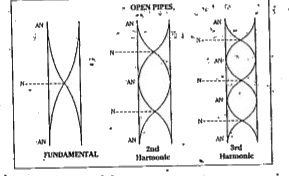Explain the formation of stationary waves in an air column enclosed in open pipe. Derive the equations for the frequencies of the harmonics produced.
Text Solution
Formation of stationary wave in open pipe : An open pipe is a cylindrical tube having air inside with both ends open.
Let a longitudinal wave pass through the organ.pipe. It gets reflected at the end of the pipe. These incident and reflected . waves which are of same frequency, travelling in opposite directions, get superposed along the length of the pipe.
As a result of it, longitudinal stationary waves are formed.
At the open end, the particles of the medium are free to vi brate and the incident and reflected waves will be in phase, so particles have maximum displacement, forming antinode. Thus the air column inside a open pipe is set into vibration due to stationary waves formed in it with antinode at each open end.
Harmonics in open pipe :
Fundamental : In the fundamental mode of vibration, an antin ode is formed at each end and a node is formed between them. The note produced is called first harmonic
If .l.. is the vibrating length and λ1 is the corresponding wave length.
l=λ12⇒λ1=2l
Fundamental frequency u1=vλ1
∴u1=v2l

Second Harmonic (or) first overtone : 2nd harmonic consists of three antinodes and two nodes.
If λ2 is the corresponding wavelength
l=λ24+λ22+λ24=λ2⇒l=λ2
∴u2=vλ2=vl=2×v2l=2v1
Third harmonic or Second overtone : 3rd harmonic consists of four antinodes and three nodes. If λ3 is the corresponding wave length
l=λ34+λ32+λ32+λ34=3λ32
λ3=2l3∴u3vλ3(OR)u3=3v2lu3=3u1
The ratio of harmonics in open pipes u1:u2:u3:=1:2:3:......
Length of closed organ pipe l = 70 cm
Velocity of sound v=331ms−1
Fundamental frequency of closed pipe
u=v4l=3314×70×10−2=331280×10−2
∴n=331×102280=n=(118.2Hz)
|
Topper's Solved these Questions
Similar Questions
Knowledge Check
In the stationary waves in an open organ pipe -
ABoth the ends are antinodes and in between them there is at least one nodeBBoth the ends are nodes and in between them there is at least one antinodeCAntinode at one end and node at the otherDBoth the ends are antinodes and in between them there is no nodeIn the stationary waves in an open organ pipe -
ABoth the ends are antinodes and in between them there is at least one nodeBBoth the ends are nodes and in between them there is at least one antinodeCAntinode at one end and node at the otherDBoth the ends are antinodes and in between them there is no node.Stationary waves in closed pipe will produce
Aall the harmonics.Ball the even harmonics.Call the odd harmonics.Dno harmonics.
Derive an equation for the first mode of vibration of an air column in a closed organ pipe.
View SolutionDerive an equation for the first mode of vibration of an air column in an open organ pipe.
View SolutionIn an open organ pipe, third harmonic has a frequency 450Hz. What is the frequency of fifth harmonic ?
View SolutionThe harmonics formed in air column in an organ pipe closed at one end are
View SolutionIn an air column, stationary waves can be produced even if the superposing waves
View Solution
